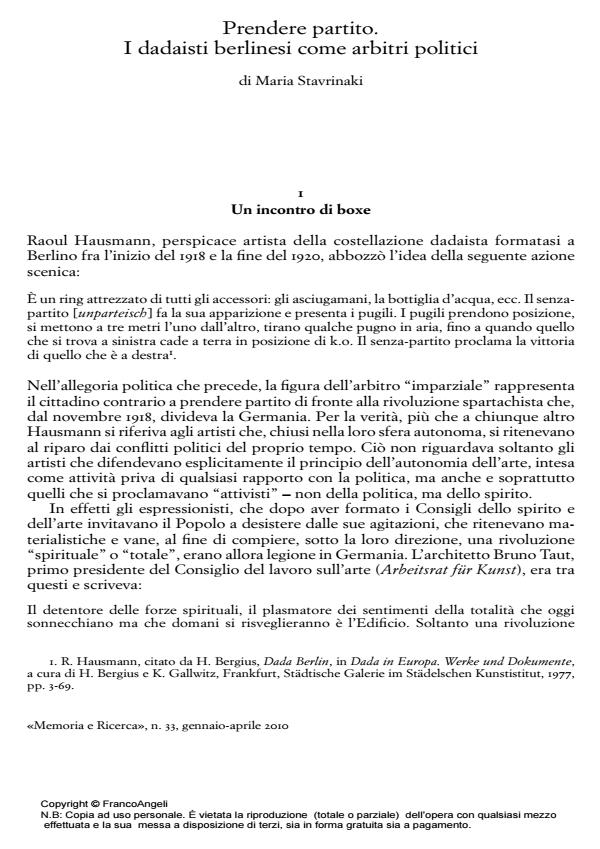Take party: the Dadaist Artists as political arbiters
Journal title MEMORIA E RICERCA
Author/s Maria Stavrinaki
Publishing Year 2010 Issue 2010/33
Language Italian Pages 19 P. 29-47 File size 489 KB
DOI 10.3280/MER2010-033003
DOI is like a bar code for intellectual property: to have more infomation
click here
Below, you can see the article first page
If you want to buy this article in PDF format, you can do it, following the instructions to buy download credits

FrancoAngeli is member of Publishers International Linking Association, Inc (PILA), a not-for-profit association which run the CrossRef service enabling links to and from online scholarly content.
The reaction of the Expressionist and the Dadaist artists towards the political situation in Germany after 1918, in regard especially to the activities of political parties, shared an "anti-mimetic" conception, rejecting political liberalism as a means for the conservation of the passive repetition of the "already existing. Nonetheless, the differences in this antimimetic conception of the political were radical. The expressionist idealism was founded on a unilateral conception of the autonomy of art: detached from the history of their times, the artists wanted to dictate the rules of the future. Highly hierarchical, their "Councils" were alternative microcosms, contrasting with the Revolution and with the democratic regime. The expressionist posture has been deconstructed with perspicacity by the dadaist works and discourse. Expressionism was interpretated as the last avatar of the Weimar classicism, defending the model of an Interiority with no political vocation, the olympian Selbst-bildung. Its political correlate was the parlementary democracy of 1919. The spiritual ideal - being it that of the classical beauty or of abstraction - acted as an obliteration of the defi ciencies of matter, in the same way that the Sacral Union of Weimar obliterated its foundations of violence: the Spartakist Revolution. Dadaist montage has been thus conceived as an instrument that had to tear up the beautiful appearances, both aesthetical and political. The use-value of the dadaist collages and assemblages was to instigate complex subjectivities, whose economy should result from the subtle and ever changing dosage of purity and impurity, spirit and matter. The essay studies the two facets of dadaist temporality, of "reproducible time": presentism and historical simultaneism.
Keywords: Expressionism, Dadaism, Mimesis, Politics, Temporality, Germany
Maria Stavrinaki, Prendere partito. I dadaisti berlinesi come arbitri politici in "MEMORIA E RICERCA " 33/2010, pp 29-47, DOI: 10.3280/MER2010-033003